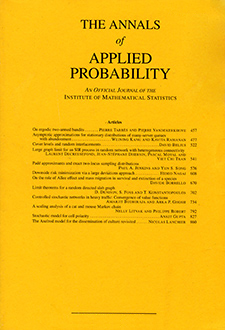Abstract
In a zero-sum stochastic game with signals (Repeated Games (2015) Cambridge Univ. Press, Chapter IV), at each stage, two adversary players make decisions and receive stage payoffs determined by these decisions and a variable called the state. The state follows a Markov chain controlled by both players. Actions and states are imperfectly observed by players, who receive private signals at each stage. Mertens (In Proceedings of the International Congress of Mathematicians, Vol. 1, 2 (Berkeley, Calif., 1986) (1987) 1528–1577 Amer. Math. Soc.) conjectured two properties regarding games with long durations: first, that a limit value always exists; second, that when Player 1 is more informed than Player 2, she can guarantee the limit value uniformly. These conjectures were recently disproved by the author (Ann. Probab. 44 (2016) 1107–1133) but remain widely open in many subclasses. A well-known particular subclass is absorbing games with incomplete information on both sides, in which the state can move at most once during the game, and players receive a private signal about it at the outset of the game. This paper proves Mertens’ conjectures in this particular model by introducing a new approximation technique of belief dynamics likely to generalize to many other frameworks. In particular, this represents a significant step towards understanding the following broad question: in which games do Mertens’ conjectures hold?
Funding Statement
This work was supported by the French Agence Nationale de la Recherche (ANR) under reference ANR-21-CE40-0020 (CONVERGENCE project).
Acknowledgments
The author is greatly indebted to Françoise Forges, Stéphane Gaubert, Fabien Gensbittel, Jérôme Renault, Raimundo Saona, Sylvain Sorin, Tristan Tomala and an anonymous reviewer for their careful rereading and insightful comments.
This paper was partially written during a visit to the Center for Mathematical Modeling (CMM) at University of Chile.
Citation
Bruno Ziliotto. "Mertens conjectures in absorbing games with incomplete information." Ann. Appl. Probab. 34 (2) 1948 - 1986, April 2024. https://doi.org/10.1214/23-AAP2011
Information





